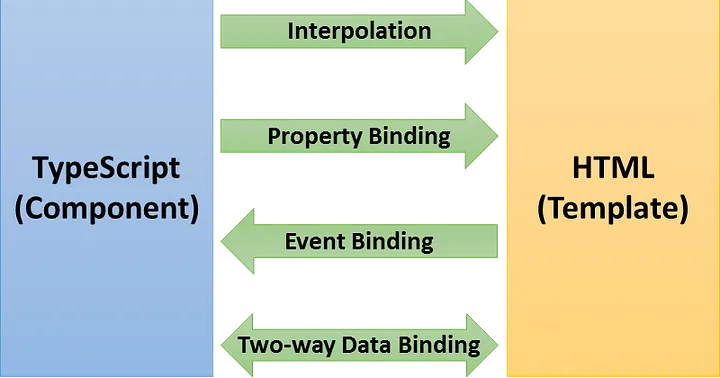Data Binding in Angular

Data Binding in Angular
What is Data Binding?
Data binding is the process of connecting the application’s data (in the component) with the user interface (in the template). This ensures that changes in the data are automatically reflected in the UI, and vice versa. Angular provides several types of data binding:
(1).Interpolation (One-Way Binding): This is the simplest form of data binding in Angular. It allows you to display component data in the template by wrapping it in double curly braces {{ }}. For example:
<h1>{{ pageTitle }}</h1>
Here, pageTitle is a property in the component class, and its value will be displayed in the <h1> element.
(2).Property Binding (One-Way Binding): This type of binding allows you to set an element’s property to the value of a component property. You use square brackets [] to bind a property. For example
<img [src]="imageUrl">
Here, the src property of the img element is bound to the imageUrl property of the component.
(3).Event Binding (One-Way Binding): Event binding allows you to respond to user events (e.g., click, input) and execute a function in the component class. You use parentheses () for event binding. For example:
<button (click)="onButtonClick()">Click me</button>
When the button is clicked, the onButtonClick method in the component class is executed.
(4).Two-Way Binding: This type of binding combines property binding and event binding to achieve bidirectional data flow. It is typically used with forms to update both the UI and the component properties simultaneously. Angular provides the [(ngModel)] directive for two-way binding. For example:
<input [(ngModel)]="userName">
Here, changes to the userName property in the component are reflected in the input field, and changes in the input field are updated in the userName property.
Setting Up Angular for Data Binding
Before you can use data binding in Angular, you need to set up an Angular application. Here’s a brief overview of the steps:
- Install Angular CLI: If you haven’t already, install the Angular CLI globally on your machine using npm (Node Package Manager):
npm install -g @angular/cli
2. Create a New Angular Project: Use the Angular CLI to create a new Angular project:
ng new my-angular-app
3.Generate a Component: Create a component to practice data binding. For example:
ng generate component my-component
4.Implement Data Binding: Inside your component’s template (my-component.component.html) and component class
(my-component.component.ts), you can implement the various types of data binding as mentioned earlier.
5.Run the Application: Start the development server to see your Angular app in action:
ng serve
Conclusion:
Data binding is a powerful feature in Angular that simplifies the interaction between your application’s data and the user interface. It allows you to create dynamic and responsive web applications with ease. Understanding the different types of data binding and how to use them effectively is essential for building Angular applications
Relevant Information:
In an era defined by digital transformation, businesses strive to stand out and reach their target audience in unique and engaging ways. One company at the forefront of this innovation is Angrio Technologies, an emerging tech powerhouse that's setting a new standard in the world of technology with its cutting-edge front-end solutions.
At Angrio Technologies, the team understands that a company's website is often the first touchpoint for potential customers. Angular, a powerful front-end framework, empowers Angrio's developers to create robust and responsive web applications that not only load quickly but provide a seamless and engaging user experience.
By creating robust web applications and cross-platform mobile apps, Angrio elevates technology performance and drives engagement to new heights. so visit now
More content at AngrioTechnologies.
Follow us on Twitter, LinkedIn
Follow me on LinkedIn